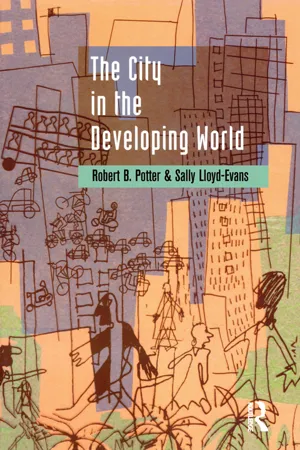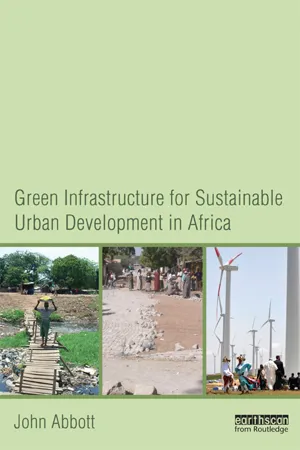Geography
African City Model
The African City Model is a conceptual framework used to understand the spatial organization and development of cities in Africa. It emphasizes the unique characteristics of African urban areas, such as informal economies, rapid urbanization, and diverse cultural influences. The model highlights the complex interplay between traditional and modern elements in shaping the urban landscape of African cities.
Written by Perlego with AI-assistance
Related key terms
2 Key excerpts on "African City Model"
- eBook - ePub
- Robert B. Potter, Sally Lloyd-Evans(Authors)
- 2014(Publication Date)
- Routledge(Publisher)
On average, African cities are smaller than those of Latin America and Asia, often consisting of between one and two million residents. It has been argued by a number of authors that there is a lack of conceptual studies which attempt to explain the structure and form of cities in an African context (Simon, 1989a). Much theorising presumes that the African city conforms closely to the pre-industrial model, an assumption which underplays the post-colonial development of African cities. Although McGee (1971) argued that smaller African cities are likely to provide the best examples of colonial city structure, it is important to understand the distinct development of African cities under the various versions of European settlement. An attempt to develop a distinct model of the African city was undertaken by the United Nations in 1973. As highlighted in Figure 6.2, the model was based on the existence of an indigenous core and the organisation of different ethnic groups through density gradients in a pattern which ascribed low-density land use to the administrative and housing requirements of the colonial elites, and high density to indigenous populations. In Southern and East African cities, segregation was maintained through strict legislation, whereas divisions were less formal in West African cities, due to the smaller numbers of settlers involved. The most extreme form of social segregation and economic division was found in South Africa’s apartheid cities, where the concept of ‘separate development’ led to the forced removal of the black population from the inner city to townships located on the periphery. Elsewhere in the city, access to urban amenities and employment was segregated according to race and wealth - John Abbott(Author)
- 2013(Publication Date)
- Routledge(Publisher)
The urban planning model used, certainly in anglophone Africa, is based upon the British system of urban planning. Unfortunately, this particular urban planning model has two fundamental flaws that convert to destructive forces when transferred to an Africa development scenario. The first is its basic rationality. Historically, urban planning was a paper-based discipline that sought to create a land-use map prior to settlement taking place. As a result, when applied in an African context, it always lagged behind the urban growth curve, and failed to demonstrate how it can move ahead of this process to create a formal plan that leads, rather than lags, the urbanisation process itself. Africa needs a different model: its own model; to define the relationship between the people and the land, which is much more interactive.The second flaw revolves around the relationship between urban planning, urban infrastructure and urban economic development. In its evolution in Britain, urban planning emerged from a development model that perceived infrastructure first as a support service for social development and second as an engineering function. In this worldview, economic development is driven by externalities, such as private-sector investment, that can be facilitated by a planning process. However, as Chapter 2 will illustrate, there is actually an alternative view, which was prevalent in the United States: that infrastructure is itself a development driver. Unfortunately, by the time that urban planning in Britain emerged from the dominant engineering paradigm in the 1970s, the bulk of the urban infrastructure base had been completed and there was no evidence to support this alternative view. Instead, the initial perception was actually entrenched by the neo-liberal approach of successive British governments. As a result, this has become the de facto urban planning model for sub-Saharan Africa.Viewed in this context, urban planning provides a classic example of how dominant cultures control the intellectual space of others. It is epitomised by the saying ‘think global, act local’. This reflects a worldview that could only emanate from a hegemonic, culturally dominant group: for who actually defines what is meant by global in a developmental context? Who defines the ‘global’ value system that underpins the development model? What we see is the power of a small, self-selecting group who dominate the intellectual debate, creating ‘models’ of planning and urban management for developing countries, and then defining their rationality through a process of self-affirmation. A model of this kind is then ‘verified’ as being a global development model by using comparative research that is based, almost exclusively, in the megacities and large urban conurbations. Once accepted as a global model, it can then be extrapolated to cover all urban areas, with local researchers expected to ‘adapt’ it to local conditions. How is it possible, under these conditions, to create an African urban spatial model?
Learn about this page
Index pages curate the most relevant extracts from our library of academic textbooks. They’ve been created using an in-house natural language model (NLM), each adding context and meaning to key research topics.

